Plumbing fittings: additional elements, without which the
Components for plumbing represent an extensive group of parts that are used in the installation of water supply systems. The use of such elements allows you to construct complex multifunctional structures that provide the maximum level of comfort during operation.
In our article we will provide information on the most common types of sanitary fittings, as well as voiced a number of recommendations on the use of certain parts.

General classification
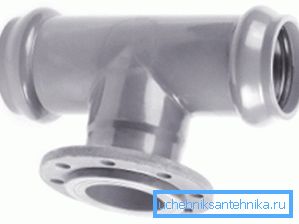
Water tees, couplings, adapters, faucets, mixers, hoses and many other elements today are widely used in the installation of water-carrying circuits. Each of these parts performs its function, but still you can conditionally divide the entire range into several large groups:
| Part Category | Functions and design features |
| Connecting |
|
| Shut-off |
|
| Measuring |
|
| Additional |
|
In addition, there is also a classification of accessories according to the material of manufacture. As a rule, all products are divided into metal, plastic and combined.
Note! The instruction recommends using the type of fittings that is most adapted to the type of pipelines used, and ideally select products from one manufacturer.
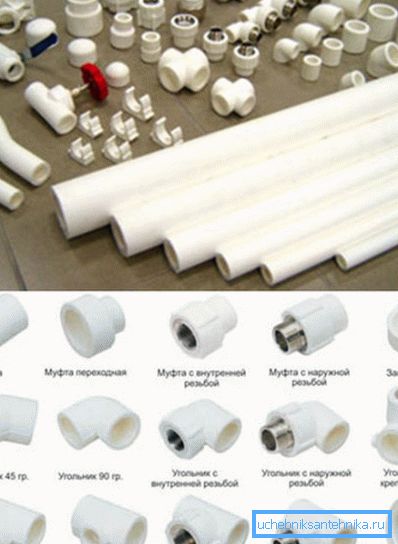
Connecting elements
Most common varieties
The connecting accessories are presented in the modern market in the widest range. A significant part of such parts are threaded fittings for pipes of different materials, and therefore we will start the analysis with them.
According to the form and purpose, there are such elements:
- Clutch - the simplest connection, equipped with thread. Used to dock two pipes without changing direction. Depending on the design, it can be used for mounting products of the same or different diameter.
Note! The part of the hardware that connects the pipes with a different cross-section of the passage is usually called an adapter. An example is a plumbing splitter, in which a more delicate branch extends from the main pipe.
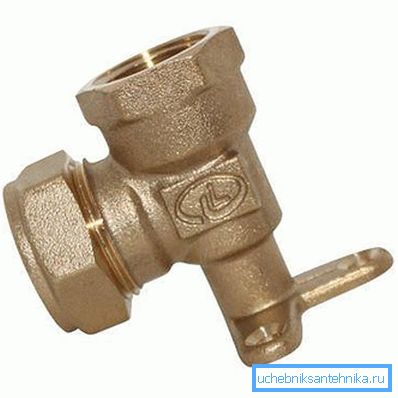
- The tee is also not difficult, but it is used for joining three sections of the pipeline. Tees are straight and angular.
- Crosses are rarely used when equipping water supply, but in the sewer they are almost indispensable. In some cases, the spider can be used as a splitter of the main circuit into three additional ones.
- The knee and the corner is used to design the turn of the highway. In most cases, it is the knee that is used in the form of parts of the arc, since the corners under 900 create too much resistance to water flow.
- Plumbing nipple - simple fitting with threaded cut on two protruding nozzles. Used to create detachable connections.

- Flange - a design that provides a reliable connection of the water mains with various designs.
- Cap for water pipes - end element, which is installed on the end portion of the circuit. It should provide reliable overlap of the pipe, but if necessary, the plug can be unscrewed and drained.
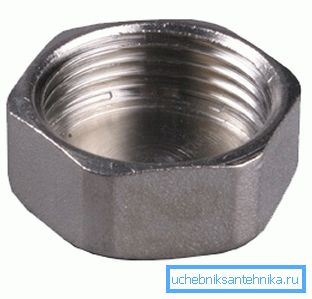
Naturally, each of these elements can be produced in the top ten, if not in a hundred modifications and sizes, so you need to carefully select the parts for installation.
Specific models for polymer products
The traditional material for the assembly of plumbing circuits is metal.
However, recently, technopolymers, which are connected using specific details, are increasingly being used as alternatives.
- Soldering fittings are usually purchased for laying polypropylene water pipes. They are made from the same material as the pipes themselves, which allows you to form permanent connections by heating and welding parts.
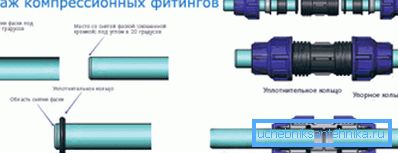
- Clamping fittings are often used to connect polyethylene pipelines.. The tightness of the site is achieved by crimping the pipe with a special insert (polymer or metal), which, in turn, is fixed with a cap nut. With proper installation and operation, this design is able to withstand a sufficiently high pressure.
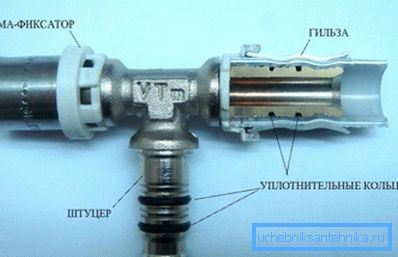
- Crimp sleeves - the most popular fittings for metal-plastic. They are used to create a permanent connection: a metal core is inserted into the pipe, which is crimped from the outside by a sleeve made of aluminum or fine brass. Due to the special design of the core, sealing rings with high tightness are formed.
As is the case with conventional fittings, these parts are produced in an extensive dimensional grid.
Pipe fittings
Faucets and mixers
The second most diverse group of furniture fittings are various taps, canisters, and mixers. As we noted above, their main task is to open or close the tube opening if necessary.
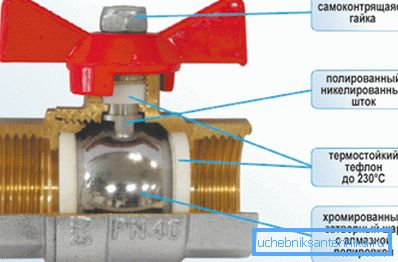
Today, the industry produces many types of cranes, but most often the following are installed:
- Ball - simple, but very reliable in operation.. The locking element is a sphere with holes, which is driven by a rigid rod. When the opening of the sphere is aligned with the hole on the body of the faucet or mixer, the passage opens and water is supplied.
Note! As a disadvantage of such products often indicate a relatively high complexity of disassembly and repair, but experienced craftsmen do quite well with such tasks.
- Boxed - easy to maintain, but somewhat less reliable. An axle box in such a crane represents a threaded cylinder, at the end of which there is either a sealing gasket or a mechanism of several ceramic plates alternately blocking the flow of water.
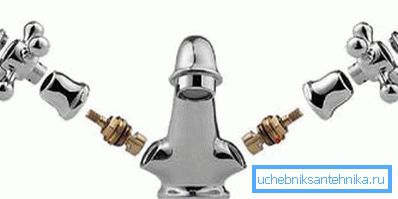
- We should also highlight the mixers with plastic cartridges. These polymer parts are used exclusively in everyday life: on the one hand, they regulate the flow of water very clearly, but on the other hand, they do not have any impressive strength.
Other components
In addition to the usual details to us, without which the functioning of the water supply system is impossible, the following can be singled out:

- The manometer for the water supply is a rather simple measuring device that records the pressure in the pipes.. Most often, manometers are equipped with contours in private houses, where the pressure is regulated by the pump.
- Plumbing gearbox - used to equalize the pressure in the system. This device can be very useful if you have doubts that the pipe connections will “survive” the effects of the water hammer.
Note! If in everyday life the installation of a reducer is highly desirable, then in industrial systems the installation of such devices is mandatory.
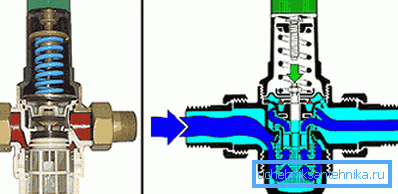
- If you do not have the opportunity to install a reducer, then it is quite possible to make a damper for a water supply system with your own hands.. Most often, expansion tanks equipped with an additional membrane are used as such systems: the device assumes increasing pressure, and the membrane compensates for a significant part of the energy due to its elasticity.
- Also do not forget about the built-in filters.These furniture elements usually crash into the contour in front of complex devices (the same gearboxes), and significantly prolong their lifespan, capturing abrasive particles suspended in water.
Conclusion
Water pressure gauge, filter, faucet, mixer, tee, nipples, couplings and other parts are no less important than the pipes themselves. That is why you should carefully study the above classification and view the video in this article: so you get at least a general idea of what elements you may need when working.